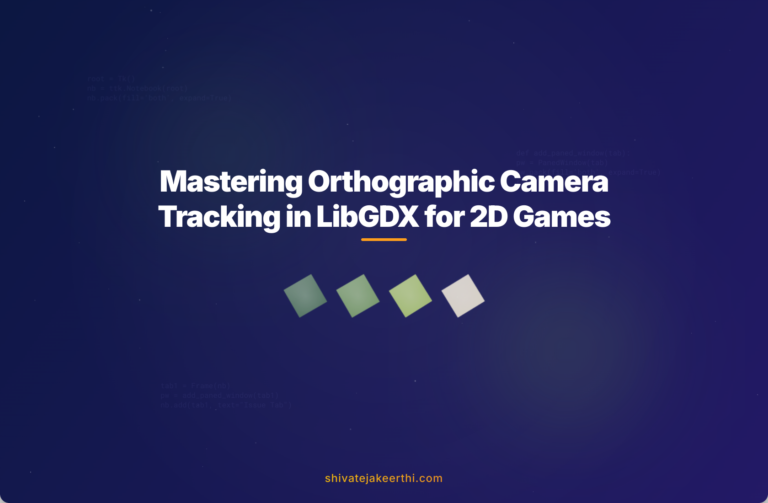When developing games with LibGDX, you might face situations where you’re working purely with shapes using the ShapeRenderer and find it challenging to get the Orthographic Camera to follow objects smoothly. Unlike working with sprites, where built-in methods facilitate camera tracking, following a ShapeRenderer object requires some extra consideration. Let’s tackle exactly how you can achieve smooth, reliable camera movements when your game doesn’t involve any sprites.
Orthographic Camera Basics: What You Need to Know
Two main camera types exist in LibGDX: Orthographic and Perspective. Perspective cameras, like those used in 3D games, create depth by scaling distant objects smaller. On the other hand, Orthographic cameras render all objects at consistent scales regardless of their distance from the camera. This makes them ideal for 2D games, especially platformers and top-down views, providing an accurate representation without perspective distortion (learn more about Orthographic projection).
In a typical LibGDX setup, your Orthographic camera works like a viewfinder. Think of it as a rectangular window that looks into your game scene without depth distortion. By moving or resizing this viewfinder, you change what portion of the game world players see during gameplay.
Why ShapeRenderer is Different from Sprites
LibGDX provides two primary methods for rendering visuals: Sprites and the ShapeRenderer. Sprites (more about Sprites) typically involve bitmap images that have built-in positioning, scaling, and rotation abilities. Libraries and tools in LibGDX have pre-built support for easily manipulating sprites.
ShapeRenderer, however, is designed purely for vector shapes like lines, rectangles, circles, polygons, and simple geometry. It’s efficient for quick prototyping, debugging collision bounds, and simple graphics without textures. But unlike sprites, you can’t directly rely on image dimensions or built-in position tracking with ShapeRenderer. You have more explicit control, but also need additional manual coding.
- Sprites: Has predefined origin, rotation, position, texture-based.
- ShapeRenderer: Manual coordinate definition, no inherent origin points, vector-based shapes.
This subtle difference explains the primary challenge: getting your Orthographic camera to smoothly follow shapes without built-in sprite utilities.
Implementing Camera Movement for ShapeRenderer Objects
Suppose you’re creating a simple ShapeRenderer-based project—let’s say a basic top-down car or spaceship that moves around your screen. To create movement, you manually update the shape’s coordinates within your render loop (using inputs, logic, or physics). The main task becomes getting your camera’s viewport to track this moving shape.
Here’s an example code snippet showing basic setup and camera following using a ShapeRenderer:
// Create and set up camera
OrthographicCamera camera = new OrthographicCamera(Gdx.graphics.getWidth(), Gdx.graphics.getHeight());
camera.position.set(carX, carY, 0);
camera.update();
ShapeRenderer shapeRenderer = new ShapeRenderer();
public void render() {
// Simulate object movement
carX += carSpeedX * Gdx.graphics.getDeltaTime();
carY += carSpeedY * Gdx.graphics.getDeltaTime();
// Update camera position to follow object
camera.position.set(carX, carY, 0);
camera.update();
shapeRenderer.setProjectionMatrix(camera.combined);
shapeRenderer.begin(ShapeRenderer.ShapeType.Filled);
shapeRenderer.setColor(Color.RED);
shapeRenderer.rect(carX - 25, carY - 10, 50, 20);
shapeRenderer.end();
}
Notice here, manual updating of the camera’s position is crucial. Since there are no built-in sprite positions, you need to explicitly set camera coordinates using the object’s coordinates before rendering.
To debug issues with camera movement, verify:
- Your object’s coordinates and the camera position update correctly every frame.
- Camera projection matrix is reset after every position update.
- No additional unintended camera transformations happening elsewhere.
Alternative Approaches to Move Camera Efficiently Without Sprites
Beyond directly setting positions:
- Lerp (Interpolation): Smooth transition instead of instantly snapping to the tracked object’s position. This prevents abrupt camera movements.
- Using vector arithmetic: Utilizing vectors to handle positioning can simplify camera logic.
Example of linear interpolation for smoother camera transitions:
camera.position.lerp(new Vector3(carX, carY, 0), 0.1f);
camera.update();
Here, the camera will gradually approach the object’s position smoothly, providing smoother gameplay experiences.
If interested in vector manipulation for easier object tracking, explore my JavaScript articles for practical geometric concepts at JavaScript category page. Concepts like vectors are identical between JavaScript and Java, making this helpful for reference.
Performance and Optimization Tips
Smooth camera transitions are not just visual—they directly impact player comfort and enjoyment. Camera lag, jitters, or frame rate drops can ruin gameplay experience.
To maintain efficiency and smoothness:
- Make use of LibGDX’s built-in deltaTime to ensure consistent movement speeds regardless of device frame rate.
- Always avoid intensive operations inside your main render loop. Keep the render loop lightweight and responsive.
- Adjust camera update parameters and interpolation strength carefully to achieve smooth movements without causing noticeable lag.
Testing and Debugging Camera Issues
Testing your camera rigorously helps avoid surprises later. Move your object to all corners of your world boundary to identify camera-related problems early. Breakpoints, logs, or built-in debug tools like LibGDX debugging tools are perfect assistants.
Common camera tracking issues include:
- Stuttering caused by inconsistent framerates or incorrect deltaTime usage.
- Incorrect calculation for object position updates leading to camera jumping suddenly.
- Viewport and world sizes mismatching, causing incorrect scaling or positioning.
Systematic debugging, logging positions at each step, and visual assistive debug shapes are highly beneficial here.
Embrace Experimentation and Keep Learning
Your capability as a developer grows tremendously from experimenting with various camera techniques. Although the lack of built-in sprite support makes camera following ShapeRenderer objects challenging, it’s an outstanding learning opportunity that strengthens your grasp on LibGDX, rendering logic, and math concepts.
Once mastered, camera controls can greatly enhance your game’s presentation, bringing it closer to professional quality. Try different interpolation values, camera offset tricks, or even shaking the camera during collisions for more dramatic gameplay.
Ready to enhance your LibGDX skills further? What unique camera effects have you considered implementing in your game projects? Share your thoughts and experiences in the comments!



0 Comments